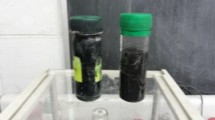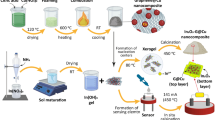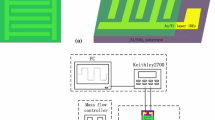Abstract
Graphene/polyaniline (Pani) nanocomposites (G/Pani) were prepared by in situ chemical oxidative polymerization using different (0–30 wt%) of graphene. According to the characterization, the presence of graphene in Pani matrix reduced the density of surface states and increased the defect density. The partial protonation of Pani and different wt% of graphene showed significant effect on CO2 gas sensing at room temperature and high humidity (ca. 90%). All prepared samples showed dynamic response and rapid recovery time to different concentrations of CO2. The nanocomposite with 20 wt% of graphene exhibited better protonation degree, sensitivity and reversibility to other samples. The sensor responded to 0.5 vol% CO2 gas three times bigger than Pani. The excellent long-term stability (about 18% less than the initial experiment) was obtained for the sensor based on G/Pani after 1 year, which makes it a potential candidate for application in CO2 gas sensor.














Similar content being viewed by others
References
Oho T, Tonosaki T, Isomura K, Ogura K (2002) A CO2 sensor operating under high humidity. J Electroanal Chem 522:173–178
Pandey S, Goswami KG, Nanda KK (2013) Nanocomposite based flexible ultrasensitive resistive gas sensor for chemical reactions studies. Sci Rep 3:1–6
Hashemi Karouei SF, Milani Moghaddam H (2019) P-p heterojunction of polymer/hierarchical mesoporous LaFeO3 microsphere as CO2 gas sensing under high humidity. Appl Surf Sci 479:1029–1038
Zhang J, Liu X, Neri G, Pinna N (2016) Nanostructured materials for room-temperature gas sensors. Adv Mater 28:795–831
Konwer S, Guha AK, Dolui SK (2013) Graphene oxide-filled conducting polyaniline composites as methanol-sensing materials. J Mater Sci 48:1729–1739. https://doi.org/10.1007/s10853-012-6931-z
Milani Moghaddam H, Nasirian S (2014) Hydrogen gas sensing feature of polyaniline/titania (rutile) nanocomposite at environmental conditions. Appl Surf Sci 317:117–124
Hee Cho K, Yu H, Seop Lee J, Jang J (2020) Facile synthesis of palladium-decorated three-dimensional conducting polymer nanofilm for highly sensitive H2 gas sensor. J Mater Sci 55:5156–5165. https://doi.org/10.1007/s10853-020-04370-7
Abdali H, Heli B, Ajji A (2019) Cellulose nanopaper cross-linked amino graphene/polyaniline sensors to detect CO2 gas at room temperature. Sensors 19:1–10
Li X, Wang G, Li X, Lu D (2004) Surface properties of polyaniline/nano-TiO2 composites. Appl Surf Sci 229:395–401. https://doi.org/10.1007/s10853-020-04370-7
Cruz-Silva R, Romero-Garcia J, Angulo-Sanchez JL, Flores-Loyola E, Farias MH, Castillon FF, Diaz JA (2004) Comparative study of polyaniline cast films prepared from enzymatically and chemically synthesized polyaniline. Polym J 45:4711–4717
Molapo KM, Ndangili PM, Ajayi RF, Mbambisa G, Mailu SM, Njomo N, Masikini M, Baker P, Iwuoha EI (2012) Electronics of conjugated polymers (I): polyaniline. Int J Electrochem Sci 7:11859–11875
Takpire SR, Waghuley SA (2015) Synthesis of copolymer in PTh-co-PANi-ti system for photovoltaic application. Mater Lett 150:9–11
Bhadra J, Popelka A, Abdulkareem A, Ahmad Z, Touati F, Al-Thani N (2019) Fabrication of polyaniline-graphene/polystyrene nanocomposites for flexible gas sensors. RSC Adv 9:12496–12506
Pandey S (2016) Highly sensitive and selective chemiresistor gas/vapor sensors based on polyaniline nanocomposite: a comprehensive review. J Sci-Adv Mater Dev 1:431–453
Pandey S, Ramontj J (2016) Rapid, Facile Microwave-assisted synthesis of Xanthan gum grafted polyaniline for chemical sensor. Int J Biol Macromol 89:89–98
Wan M (2008) Conducting polymers with micro or nanometer structure. Tsinghua University Press, Beijing
Macdiarmid AG, Chiang JC, Richter AF, Epstein AJ (1987) Polyaniline: a new concept in conducting polymers. Synth Met 18:285–290
Lv C, Hu C, Luo J, Liu S, Qiao Y, Zhang Z, Song J, Shi Y, Cai J, Watanabe (2019) A recent advances in graphene-based humidity sensors. Nanomater 9:1–42
Ogura K, Shiigi H (1999a) A CO2 composite film consisting of base-type polyaniline and poly (vinyl alcohol). Electrochem Solid-State Lett 2:478–480
Wu Z, Chen X, Zhu S, Zhou Z, Yao Y, Quan W, Liu B (2013) Enhanced sensitivity of ammonia sensor using graphene/polyaniline nanocomposite. Sens Actuator B Chem 178:485–493
Pumera M (2009) Electrochemistry of graphene: new horizons for sensing and energy storage. Chem Rec 9:211–223
Krach F, Hertel S, Waldmann D, Jobst J, Krieger M, Reshanov S, Schoner A, Weber HB (2012) A switch for epitaxial graphene electronics: utilizing the silicon carbide substrate as transistor channel. Appl Phys Lett 100:122102–122105
Tung NT, Van Khai T, Jeon M, Lee YJ, Chung H, Bang JH, Sohn D (2011) Preparation and characterization of nanocomposite based on polyaniline and graphene nanosheets. Macromol Res 19:203–208
Zhou X, Wu T, Hu B, Yang G, Han B (2010) Synthesis of graphene/polyaniline composite nanosheets mediated by polymerized ionic liquid. Chem Commun 46:3663–3665
Yan J, Wei T, Shao B, Fan Z, Qian W, Zhang M, Wei F (2010) Preparation of a graphene nanosheet/polyaniline composite with high specific capacitance. Carbon 48:487–493
Al-Mashat L, Shin K, Kalantarzadeh K, Plessis JD, Han SH, Kojima RW, Kaner RB, Li D, Gou X, Ippolito SJ, Wlodarski W (2010) Graphene/polyaniline nanocomposite for hydrogen sensing. J Phys Chem C 114:16168–16173
Yassin Y, Mohamed AR, Abdelrazek ME, Morsi AM, Abdelghanye AM (2019) Structural investigation and enhancement of optical, electrical and thermal properties of poly (vinyl chloride-co-vinyl acetate-co-2-hydroxypropyl acrylate)/graphene oxide nanocomposites. J Mater Res Technol 8:1111–1120
Mamma K, Siraj K, Meka N (2013) Synthesis and effect of secondary dopant on the conductivity of o polyaniline. J Polym Eng 33:785–792
Borah R, Banerjee S, Kumar A (2014) Surface functionalization effects on structural, conformational, and optical properties of polyaniline nanofibers. Synth Met 197:225–232
Tigelaar DM, Lee W, Bates KA, Saprigin A, Prigodin VN, Cao X, Nafie LA, Platz MS, Epstein AJ (2002) Role of solvent and secondary doping in polyaniline films doped with chiral camphorsulfonic acid: preparation of a chiral metal. Chem Mater 14:1430–1438
Nasirian S, Milani Moghaddam H (2014) Hydrogen gas sensing based on polyaniline/anatase titania nanocomposite. Int J Hydrogr Energy 39:630–642
Patil SV, Deshmukh PR, Lokhande CD (2011) Fabrication and liquefied petroleum gas (LPG) sensing performance of p-polyaniline/n-PbS heterojunction at room temperature. Sens Actuator B Chem 156:450–455
Lin W, Xu K, Xin M, Peng J, Xing Y, Chen M (2014) Hierarchical porous polyaniline silsesquioxane conjugated hybrids with enhanced electrochemical capacitance. RSC Adv 4:39508–39518
Nimkar SH, Agrawal SP, Kondawar SB (2015) Fabrication of electrospun nanofibers of titanium dioxide intercalated polyaniline nanocomposites for CO2 gas sensor. Procedia Mater Sci 10:572–579
Hatchett DW, Josowicz M, Janata J (1999) Acid doping of polyaniline: spectroscopic and electrochemical studies. J Phys Chem B 103:10992–10998
Dhand C, Das M, Sumana G, Srivastava AK, Pandey MK, Kim CG, Datta M, Malhotra BD (2010) Preparation, characterization and application of polyaniline nanospheres to biosensing. Nanoscale 2:747–754
Nacer B, Syed K, Roy Aashis S (2016) Micro-Raman spectroscopy and effective conductivity studies of graphene nanoplatelets/polyaniline composites. J Mater Sci Mater Electron 27:6249–6257
Kang ET, Neoh KG, Tan TC, Khor SH (1990) Structural studies of poly (p-phenyleneamine) and its oxidation. Macromolecules 23:2918–2926
Malard LM, Pimenta MA, Dresselhaus G, Dresselhaus MS (2009) Raman spectroscopy in graphene. Phys Rep 473:51–87
Kuo CC, Chen CH (2014) Graphene thickness-controlled photocatalysis and surface enhanced Raman scattering. Nanoscale 6:12805–12813
Li T, Wang X, Liu P, Yang B, Diao S, Gao Y (2020) Synthesis of graphene/polyaniline copolymer for solid-state supercapacitor. J Electroanal Chem 860:113908–113917
Yuan W, Li B, Li L (2011) A green synthetic approach to graphene nanosheets for hydrogen adsorption. Appl Surf Sci 257:10183–10187
Chen L, Zhao Y, Hou H, Zhang T, Liang J, Li M, Li J (2019) Development of AZ91D magnesium alloy-graphene nanoplatelets composites using thixomolding process. J Alloys Compd 778:359–374
Khasim S (2019) Polyaniline-Graphene nanoplatelet composite films with improved conductivity for high performance X-band microwave shielding applications. Results Phys 12:1073–1081
Stankovich S, Dikin A, Piner DDR, Kohlhaas AK, Kleinhammes A, Jia Y, Wu Y, Nguyen TSS, Ruoff R (2007) Synthesis of graphene-based nanosheets via chemical reduction of exfoliated graphite oxide. Carbon 45:1558–1565
Yu H, Wang T, Wen B, Lu M, Xu Z, Zhu C, Chen Y, Xue X, Sun C, Cao M (2012) Graphene/polyaniline nano-rod arrays: synthesis and excellent electromagnetic absorption properties. J Mater Chem 22:21679–21685
Ferrari AC (2007) Raman spectroscopy of graphene and graphite: Disorder, electron-phonon coupling, doping and nonadiabatic effects. Solid State Commun 143:47–57
Akin N, Ozen Y, Efkere HI, Cakmak M, Ozcelik S (2015) Surface structure and photoluminescence properties of AZO thin films on polymer substrates. Surf Interface Anal 47:93–98
Korotcenkov G (2007) Metal oxides for solid-state gas sensors: What determines our choice? Mater Sci Eng B 139:1–23
Nimkar SH, Kondawar SB, More PS (2015) Polyaniline/TiO2 nanocomposite thin film based carbon dioxide gas sensor. Int J Res Biosci Agric Technol 12–18
Waghuley SA, Yenorkar SM, Yawale SS, Yawale SP (2008) Application of chemically synthesized conducting polymer-polypyrrole as a carbon dioxide gas sensor. Sens Actuators B Chem 128:366–373
Mude KM, Mude BM, Raulkar KB, Yawale SS, Yawale SP (2017) Conducting polymer polyaniline as CO2 gas sensor. Int J Chemtech Res 10:494–500
Ogura K, Shiigi H, Oho T, Tonosaki T (2000) A CO2 sensor with polymer composites operating at ordinary temperature. J Electrochem Soc 147:4351–4355
Nyflott A, Mericer C, Minelli M, Moons E, Jarnstrom L, Lestelius M, Baschetti MG (2017) The influence of moisture content on the polymer structure of polyvinyl alcohol in dispersion barrier coatings and its effect on the mass transport of oxygen. J Coat Technol Res 14:1345–1355
Li H, Zhang W, Xu W, Zhang X (2000) Hydrogen bonding governs the elastic properties of poly (vinyl alcohol) in water: single-molecule force spectroscopic studies of PVA by AFM. Macromolecules 33:465–469
Mitra S, Banerjee S, Chakravorty D (2013) Tunneling conduction in graphene/(poly)vinyl alcohol composite. J Appl Phys 113:154314–154320
Bhadra J, Al-Thani NJ, Madi NK, Al-Maadeed AM (2013) Preparation and characterization of chemically synthesized polyaniline-polystyrene blends as a carbon dioxide gas sensor. Synth Met 181:27–36
Yang Y, Heeger AJ (1994) Polyaniline as a transparent electrode for polymer light-emitting diodes: lower operating voltage and higher efficiency. Appl Phys Lett 64:1245–1247
Cao Y, Treaty GM, Smith P, Heeger AJ (1992) Solution-cast films of polyaniline: optical-quality transparent electrodes. Appl Phys Lett 60:2711–2713
Zhang X, Yan G, Ding H, Shan Y (2007) Fabrication and photovoltaic properties of self-assembled sulfonated polyaniline/TiO2 ultrathin films. Mater Chem Phys 102:249–254
Nicolas-Debarnot D, Poncin-Epaillard F (2003) Polyaniline as a new sensitive layer for gas sensors. Anal Chim Acta 475:1–15
Ogura K, Shiigi H (1999b) A CO2 composite film consisting of base-type polyaniline and poly (vinyl alcohol). Electrochem Solid State Lett 2:478–480
Wang RX, Huang LF, Tian XY (2012) Understanding the protonation of polyaniline and polyaniline-graphene interaction. J Phys Chem C 116:13120–13126
Naidu KS, Palaniappan S (2020) Formation of PANI-PVA salt via H-bonding between PVA and PANI: aqueous coating for electrostatic discharge, sensor and corrosion. Sens Int 1:100006–100015
Acknowledgements
This research did not receive any specific grant from funding agencies in the public, commercial or not-for-profit sectors.
Author information
Authors and Affiliations
Corresponding author
Additional information
Handling Editor: Joshua Tong.
Publisher's Note
Springer Nature remains neutral with regard to jurisdictional claims in published maps and institutional affiliations.
Rights and permissions
About this article
Cite this article
Hashemi Karouei, S., Milani Moghaddam, H. & Saadat Niavol, S. Characterization and gas sensing properties of graphene/polyaniline nanocomposite with long-term stability under high humidity. J Mater Sci 56, 4239–4253 (2021). https://doi.org/10.1007/s10853-020-05532-3
Received:
Accepted:
Published:
Issue Date:
DOI: https://doi.org/10.1007/s10853-020-05532-3




